Lesson 21 (2)
Right hand continues over to left hand. Close fingers of left hand around it apparently to take coin. Remove right hand and completely close left hand. Figure 39.
Open left hand slowly to show it empty with the coin gone. Figure 40.

Remember NEVER TO LOOK AT THE HAND WHICH CONCEALS THE COIN but look at the other hand and the eyes of the audience will follows yours -- simple misdirection.
6 -- Finger Palm Vanish.
This is another simple natural vanish. Hold coin in Flat Finger Position (Figure 23) as shown in Figure 41.
As you turn hand over toward left, curl under your second, third, and fourth fingers to grip coin and palm it in regular Finger Palm style. Figure 42.
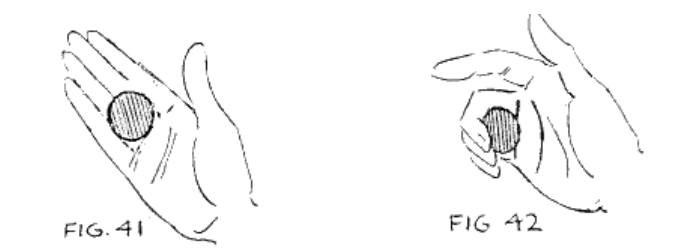
Coin is apparently thrown into left hand, which closes about it at the right moment. Then hand is opened and coin has disappeared.
7 -- Lift Up Vanish.
Place coin in left hand in Flat Finger Position and show it freely to audience. Figure 43.
Reach down with right hand, apparently picking up coin. Just as you pretend to lift coin, turn left hand slightly toward your body so that coin is concealed from audience. Finger Palm coin in left hand and point index finger at right hand, which continues upward in its movement of pretending to carry coin away. Figure 44.
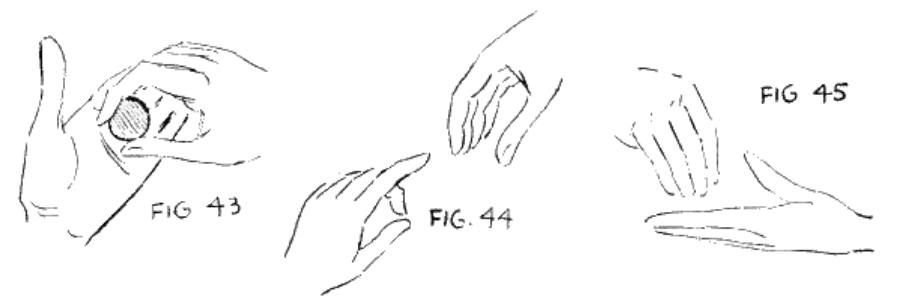
Figure 45 shows you the effect to the audience. The movement is so natural that they do not suspect that you do not have the coin in right hand.
Close right hand, squeeze it over imaginary coin, then open it, and coin has vanished.
8 -- Invisible Thumb Vanish.
Hold coin as in Figure 26. Curve fingers inward to position shown in Figure 27 as you pretend to throw coin into left hand. From this point, however, do not continue with the Front Thumb Palm. Hold coin in position at crotch of thumb so that it can be gripped at edges as shown in Figure 46.
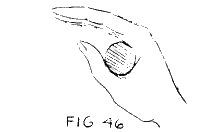
Now hand may be shown on both sides. When hand is shown from the back, the coin is not visible to audience. When hand is turned to show front, curve fingers inward to conceal coin. Then fingers may be straightened again to show hand from front. Figures 47 and 48.
When hand is dropped, it is easy to let coin fall into the regular Finger Palm.

This is an old timer and is very simple. Coin is held in Thumb-Fingertip Horizontal position (Figure 18). Cover coin with right hand, allowing thumb to come under coin. Figure 49.
Now allow coin to drop into Finger Palm position in left hand. Close right hand as if you had actually lifted up coin from left hand and carried it away in right. Figure 50.
Left hand may then be dropped to side as right hand is opened to show the coin gone.
10 -- Pick Up Vanish.
Hold coin in left hand by the Thumb-Fingertip Vertical Hold (Figures 19 and 20). Reach down with right hand as if to pick up coin. Figure 51.
As right hand screens coin from audience, let the coin slip down into Finger Palm position in left hand. Figure 52.

Take right hand away as though holding coin, close it, and pretend to vanish coin. Then open hand and show it empty.
11 -- Front and Back Finger Palming.
Only one hand is used in this method of vanishing a coin and both sides of hand are shown to audience.
This method requires some skill; therefore, it will require real practice before you are ready to use it. Downs and Manuel can Front and Back Palm a quantity of coins -- even a dozen or two would be easy for them. Such work requires too much skill, however, for the average magician. I shall teach you other methods of handling a quantity of coins later on in the course. We begin here to learn how to master this principle with one coin.
Hold coin in Front Finger Palm position (Figure 11). Remember coin is gripped on both sides by first and fourth fingers. Figure 53.
Curve second and third fingers under coin, holding coin securely between first and fourth fingers. Figure 54.

Let coin revolve as fingers go under it. Figure 55.
Study these moves out very slowly, but remember that, of course, they are performed very quickly and as one continuous movement.
Straighten out fingers. This brings coin automatically to back of hand in same position as it was on front of hand. Palm of hand is shown to audience and it appears that the coin has vanished. Figures 56 and 57.
This first movement of getting coin from front to back of hand should be done with a big move of the whole arm. Arm is lowered slightly, then raised as though tossing coin in air. As you do this, curve fingers under coin and pivot coin to back of hand.
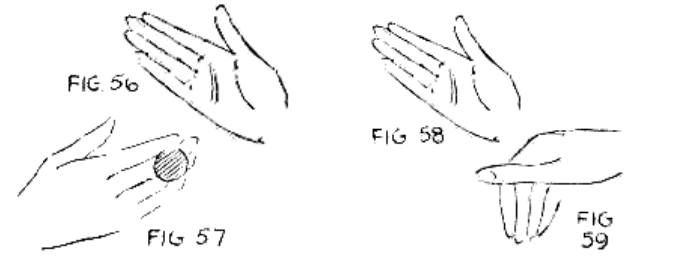
Now to show back of hand and yet conceal coin:
Coin is on back of hand after completing the above movements. Figures 58 to 62 show how the movements of getting the coin to front of hand again appear to the audience.
Start with hand in position shown in Figure 58, coin on back of hand.
Turn fingers downward and thumb straight over them as in Figure 59.

Now bring thumb downward, turning back of hand toward audience. Figure 60.
Slide second and third fingers out from under coin, pivoting coin with them. Figure 61.
Straighten fingers out behind coin so that it is now held Front Finger Palmed again. Back of hand may now be shown to audience. Figure 62.
To show front of hand again and conceal coin:
Just reverse movements of getting coin from back to front. Start with position shown in Figure 62 and work back to Figure 58.

Figure 63 shows position of arm and body in doing the Front and Back Finger Palming. Right side of body is turned away from audience. Right arm is held out at side with hand elevated.
Master this principle with BOTH hands. You are then able to get effects apparently using one coin, but in reality using two, one in each hand. When one is exposed in one hand, the other is concealed in the other hand. You can apparently pass a coin from the hand to the elbow, through the knees, etc. It is well, then, to have the principle at your command.
12 -- Back Finger Clip Vanish.
Hold coin as shown in Figure 64. This is also a one-hand vanish.
The real grip comes between tip of thumb and second joint of second finger. Lift up index finger from coin. Figure 65.
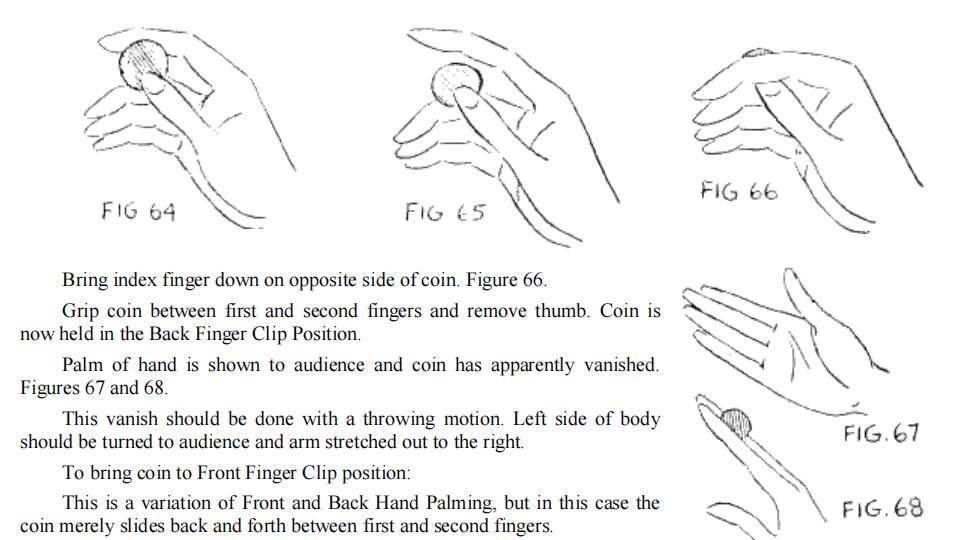
Bring index finger down on opposite side of coin. Figure 66.
Grip coin between first and second fingers and remove thumb. Coin isnow held in the Back Finger Clip Position.
Palm of hand is shown to audience and coin has apparently vanished.Figures 67 and 68.
This vanish should be done with a throwing motion. Left side of bodyshould be turned to audience and arm stretched out to the right.
To bring coin to Front Finger Clip position:
This is a variation of Front and Back Hand Palming, but in this case thecoin merely slides back and forth between first and second fingers.
Close hand so that tip of thumb can rest easily on coin. Thumb holds coin tight against second finger while first finger moves to opposite edge of coin. Thumb also aids in pulling coin forward. Figure 69.
Straighten first and second fingers, holding coin clipped between them. Remove grip of thumb. Coin is now in Front Finger Clip position. Figure 70.

During these movements the hand is turned with back toward audience. WATCH YOUR ANGLE OF VISIBILITY on these positions. Figure 71.
Figure 72 shows how wrist is bent slightly backward in making these movements so that audience cannot see coin being transferred from Back to Front Finger Clip.
To bring coin from front to back of hand again:
While back of hand is toward audience, place thumb against coin. Push coin between fingers to bring it to Back Finger Clip Position as you turn hand to show empty palm. Thumb screens coin until it is in back position, then it is raised and hand shown as in Figure 67.
TO GET RID OF COIN AFTER VANISHING IT IN HAND
To the audience the coin has vanished when the hand is opened, but to the performer there still remains the problem of disposing of the coin which is still in one of his hands.
The best place for depositing the coin is in one of your pockets. I described the Top Pocket Vanish before in this lesson.
Let us assume that coin is in your right hand. You want to dispose of it by dropping it into your right trouser's pocket. To do this without being detected requires MISDIRECTION.
Reach out with left hand before you open it to show that coin has vanished. As you reach forward, the body bends forward, and the right hand automatically comes near the right trouser's pocket. Have left side of body toward audience, and as your left arm swings forward to pretend to give coin to an assistant or to vanish it, slip fingers of right hand into pocket and drop coin there. Remove right hand from pocket immediately. Figure 73 shows view away from audience.

When you have perfected this move, you may even have front of body toward audience. Lean forward and make throwing motion with left hand and you will secure sufficient MISDIRECTION to enable you to drop coin in right trouser's pocket without detection. Other methods may be used, such as the following: Turn left side to audience and pick up something from table with left hand, at the same time dropping coin into right pocket.
You may use the same moves for getting coin into coat pocket -- also for getting the coin from left hand into left pocket.
Many times in vanishing a coin I do not hurry to get rid of it, but take my time and drop it into my pocket when reaching for a handkerchief or some other article. Or sometimes I lay it on the table where it can't be seen when I reach for my wand.
THE ELUSIVE CHANGE-OVER PALM
This is a principle which enables you to show both hands empty in a casual way without calling attention to the fact that the coin is gone. The coin is, of course, concealed in one of your hands.
Let us assume that you have the coin Thumb Palmed in your right hand. Bring left hand up to it and grasp coin between tips of second and third fingers. Figure 74.

Curve fingers inward to palm of hand. This brings coin into Curled Finger Tip Palm position in left hand. Figure 75.
Right hand may now be shown freely for coin is in left hand. Reverse movement and place coin back to Thumb Palm position. This frees left hand, which may be shown to audience. That is the way the principle works.
This is the way your hands look to the audience. You have coin in right hand, Thumb Palmed, and audience sees back of right hand and palm of left. Now swing your body to the right side. As your hands pass in front, they naturally come together and you take coin in left fingers. Figures 76 and 77.

Movement to right continues. Palm of right hand, then, comes into view and back of left hand, which now has the coin Curled Finger Tip Palmed. Figure 78.
Audience has apparently seen both sides of hands. You need not say anything about your hands being empty. Merely use Suggestion.
Practice before your mirror, working out each movement carefully. Master the principle with both hands, also starting with coin Front Thumb Palmed in the left hand, then swinging to the left.
THE THUMB CHANGE-OVER
This is another Change-Over principle which is very useful.
Coin is Front Thumb Palmed in right hand. Right side of body is toward audience and hands are held up at left side, backs of both hands to audience. Figure 79.
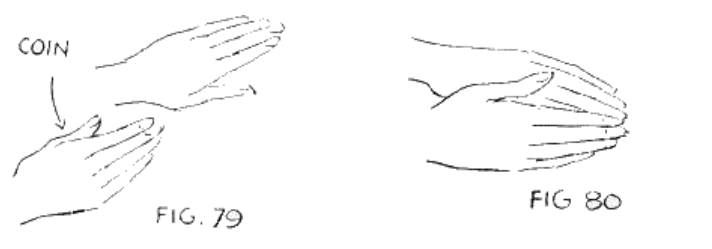
Bring left hand down until front of right thumb is over back of left thumb. Change coin over from Front Thumb Palm position in right hand to Back Thumb Palm position in left hand. Figure 80.
Swing hands up together to front so that palms are toward audience. Spectators have now seen both backs and palms of your hands and think nothing is concealed. Figure 81.

Hold hands up at level of chest. Move them apart to show that you have nothing between them. Figure 82.
Reverse movements again to show backs of hands and get coin into Front Thumb Palm position with hands as in Figure 79.
Practice also bringing coin back into view as in Figure 21, the Production Clip. It is easy to bring coin from almost any Palm into this position. Study it until you can do it skillfully.
There is much in this lesson to keep you busy, and I hope by the time you receive Lesson 22 you will be well advanced in your mastery of Coin Sleights.
TARBELL SYSTEM, INCORPORATED, Chicago.
Bạn đang đọc truyện trên: truyentop.pro